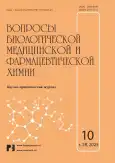The prognostic value of blood plasma biomarkers in Alzheimer's disease in an experiment: the regression analysis results
- Authors: Pozdnyakov D.I.1, Kharitonova O.V.1, Urumova I.T.1
-
Affiliations:
- Volgograd State Medical University Ministry of Health of Russian Federation
- Issue: Vol 28, No 10 (2025)
- Pages: 66-72
- Section: Problems of experimental biology and medicine
- URL: https://journals.eco-vector.com/1560-9596/article/view/693130
- DOI: https://doi.org/10.29296/25877313-2025-10-09
- ID: 693130
Cite item
Abstract
Introduction. Alzheimer's disease is a common form of terminal dementia, the diagnosis of which is complex and requires an integrated approach. Current research shows that serum biomarkers can have high prognostic value.
The aim of the study – to establish the presence of dependencies between the concentration of tau protein in the hippocampus and some serum biomarkers in rats with experimental Alzheimer's disease.
Material and methods. Alzheimer's disease was modeled in Wistar rats by direct injection of β-amyloid aggregates into the CA1 segment of the hippocampus. After 28 days, the rats for changes in the concentration of tau protein in the hippocampus, as well as tau protein, Aß, interleukin 6, 1, 2, tumor necrosis factor-α, glial fibrillar acid protein, neuron-specific enolase, protein S100ß, neurotrophic factor of the brain, light chains of neurofilament, neuroregulin, neuropeptide Y, preseniline-1, citrate synthase, succinate dehydrogenase, cytochrome c oxidase and hydrogen peroxide in blood plasma were assessed.
Results. During the work, it was shown that in rats with experimental Alzheimer's disease, there was a significant increase in the concentration of tau protein in hippocampal tissue, which was strongly correlated with the content of tau protein, β-amyloid, glial fibrillar acid protein and brain neurotrophic factor in animal blood plasma. There was also an increase in the concentration of interleukin 6, 1, 2, tumor necrosis factor-α, neuron-specific enolase, protein S100ß, light chains of neurofilament, neuroregulin, neuropeptide Y, presenilin-1 and hydrogen peroxide with a decrease in the content of citrate synthase, succinate dehydrogenase, cytochrome c oxidase. However, these changes were unreliable and poorly correlated with the tau protein content in the rat hippocampus.
Conclusion. It was shown that tau protein, β-amyloid, glial fibrillar acid protein and brain neurotrophic factor have the highest prognostic value among the analyzed blood plasma biomarkers.
Full Text
About the authors
D. I. Pozdnyakov
Volgograd State Medical University Ministry of Health of Russian Federation
Author for correspondence.
Email: pozdniackow.dmitry@yandex.ru
ORCID iD: 0000-0002-5595-8182
SPIN-code: 6764-0279
Ph.D. (Pharm.), Associate Professor, Head of the Department of Pharmacology with Clinical Pharmacology Course, Pyatigorsk Medical-Pharmaceutical Institute – Branch
Russian Federation, Kalinina Avenue, 11, Pyatigorsk, 357532O. V. Kharitonova
Volgograd State Medical University Ministry of Health of Russian Federation
Email: incentra@mail.ru
ORCID iD: 0000-0001-7840-9269
SPIN-code: 5611-4313
Ph.D. (Biol.), Associate Professor of the Department of Biological Chemistry, Pyatigorsk Medical-Pharmaceutical Institute – Branch
Russian Federation, Kalinina Avenue, 11, Pyatigorsk, 357532I. T. Urumova
Volgograd State Medical University Ministry of Health of Russian Federation
Email: it.urumova@mail.ru
ORCID iD: 0009-0004-2999-4261
Student, Pyatigorsk Medical-Pharmaceutical Institute – Branch
Russian Federation, Kalinina Avenue, 11, Pyatigorsk, 357532References
- Khan S., Barve K.H., Kumar M.S. Recent Advancements in Pathogenesis, Diagnostics and Treatment of Alzheimer's Disease. Curr Neuropharmacol. 2020; 18(11): 1106–1125. doi: 10.2174/1570159X18666200528142429.
- Beata B.K., Wojciech J., Johannes K. et al. Alzheimer's Disease-Biochemical and Psychological Background for Diagnosis and Treatment. Int J Mol Sci. 2023; 24(2): 1059. doi: 10.3390/ijms24021059.
- Shih Y.C., Tzeng B.H., Tsai M.C. et al. 18F-Florbetaben PET/CT for the Diagnosis and Subtyping of Cardiac Amyloidosis: A Case Series and Review of the Literature. Acta Cardiol Sin. 2024; 40(5): 635–643. doi: 10.6515/ACS.202409_40(5).20240617D.
- Monteiro A.R., Barbosa D.J., Remião F., Silva R. Alzheimer's disease: Insights and new prospects in disease pathophysiology, biomarkers and disease-modifying drugs. Biochem Pharmacol. 2023; 211: 115522. doi: 10.1016/j.bcp.2023.115522.
- Shi L., Baird A.L., Westwood S. et al. A Decade of Blood Biomarkers for Alzheimer's Disease Research: An Evolving Field, Improving Study Designs, and the Challenge of Replication. J Alzheimers Dis. 2018; 62(3): 1181–1198. doi: 10.3233/JAD-170531.
- Rostagno A.A. Pathogenesis of Alzheimer's Disease. Int J Mol Sci. 2022; 24(1): 107. doi: 10.3390/ijms24010107.
- García-Morales V., González-Acedo A., Melguizo-Rodríguez L. et al. Current Understanding of the Physiopathology, Diagnosis and Therapeutic Approach to Alzheimer's Disease. Biomedicines. 2021; 9(12): 1910. doi: 10.3390/biomedi-cines9121910.
- Kim H.Y., Lee D.K., Chung B.R. et al. Intracerebroventricular Injection of Amyloid-β Peptides in Normal Mice to Acutely Induce Alzheimer-like Cognitive Deficits. J Vis Exp. 2016; 109: 53308. doi: 10.3791/53308.
- Nabers A., Perna L., Lange J. et al. Amyloid blood biomarker detects Alzheimer’s disease. EMBO Mol. Med. 2018; 10(5): e8763. doi: 10.15252/emmm.201708763.
- Zarrouk A., Debbabi M., Bezine M. et al. Lipid biomarkers in Alzheimer’s Disease. Curr. Alzheimer Res. 2018; 15(4): 303–312. doi: 10.2174/1567205014666170505101426.
- Bailey M., Ilchovska Z.G., Hosseini A.A., Jung J. Impact of Apolipoprotein E ε4 in Alzheimer's Disease: A Meta-Analysis of Voxel-Based Morphometry Studies. J Clin Neurol. 2024; 20(5): 469–477. doi: 10.3988/jcn.2024.0176.
- Lim Y.Y., Villemagne V.L., Laws S.M. et al. Effect of BDNF Val66Met on memory decline and hippocampal atrophy in prodromal Alzheimer’s disease: a preliminary study. PLoS One. 2014; 9(1): e86498. doi: 10.1371/journal.pone.0086498.
- Tracy T.E., Sohn P.D., Minami S.S. et al. Acetylated tau obstructs KIBRA-mediated signaling in synaptic plasticity and promotes tauopathy related memory loss. Neuron. 2016; 90(2): 245–260. doi: 10.1016/j.neuron.2016.03.005.
- Piancatelli D., Aureli A., Sebastiani P. et al. Gene- and Gender-Related Decrease in Serum BDNF Levels in Alzheimer's Disease. Int J Mol Sci. 2022; 23(23): 14599. doi: 10.3390/ijms232314599.
- Şenses Dinç G., Çöp E., Göker Z. et al. Serum Brain-Derived Neurotrophic Factor (BDNF) Level in Children with Specific Learning Disabilities. Özgül Öğrenme Bozukluğu Olan Çocuklarda Serum Beyin Kaynaklı Nörotrofik Faktör (BKNF) Düzeyi. Turk Psikiyatri Derg. 2020; 31(3): 185–191. doi: 10.5080/u25277.
- Bharani K.L., Ledreux A., Gilmore A. et al. Serum pro-BDNF levels correlate with phospho-tau staining in Alzheimer's disease. Neurobiol Aging. 2020; 87: 49-59. doi: 10.1016/j.neurobiolaging.2019.11.010.
- Rajendran K., Krishnan U.M. Biomarkers in Alzheimer's disease. Clin Chim Acta. 2024; 562: 119857. doi: 10.1016/j.cca.2024.119857.
Supplementary files






